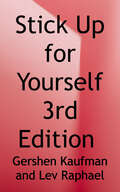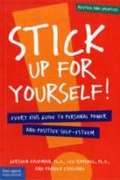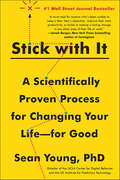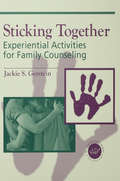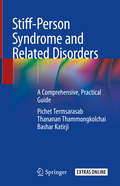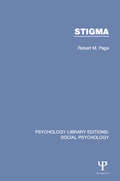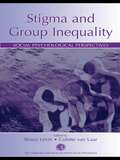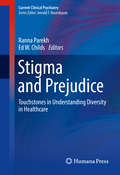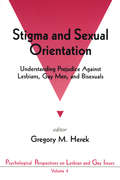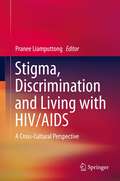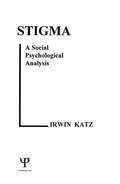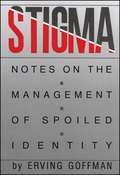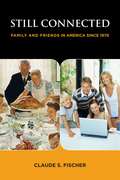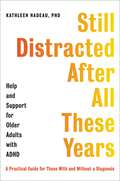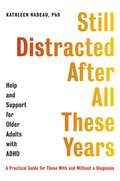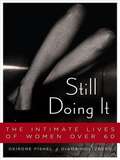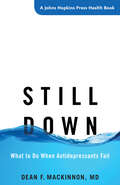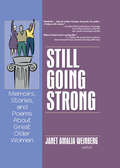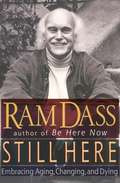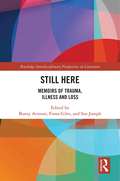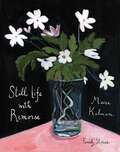- Table View
- List View
Stick Up for Yourself!: Every Kid's Guide to Personal Power and Positive Self-Esteem
by Lev Raphael Gershen KaufmanFully refreshed to address modern issues, this popular essential guide helps kids build self-confidence and assert themselves. <p><p>Using simple words and real-life examples, this book shows kids how to be assertive with other kids--and with adults. Kids will learn to feel better about themselves, stronger and more secure inside, and more in charge of their lives. They'll read about effective ways to deal with intense feelings and to build self-esteem and self-confidence. <p><p>In addition, they'll learn strategies for building inner security to cope with powerlessness and uncertainty and discover ways of protecting themselves when using social media.
Stick up for Yourself!: Every Kid's Guide to Personal Power and Positive Self-Esteem
by Lev Raphael Gershen Kaufman Pamela EspelandSimple words and real-life examples help kids build genuine self-esteem, assertiveness skills, responsibility, and relationships.
Stick with It: A Scientifically Proven Process for Changing Your Life—for Good
by Sean D. Young#1 Wall Street Journal BestsellerAn award-winning psychologist and director of the UCLA Center for Digital Behavior shows everyone how to make real, lasting change in their lives in this exciting work of popular psychology that goes beyond The Power of Habit with science and practical strategies that can alter their problem behaviors—forever.Whether it’s absent-minded mistakes at work, a weakness for junk food, a smart phone addiction, or a lack of exercise, everyone has some bad habit or behavior that they’d like to change. But wanting to change and actually doing it—and sticking with it—are two very different things.Dr. Sean Young, an authoritative new voice in the field of behavioral science, knows a great deal about our habits—how we make them and how we can break them. Stick with It is his fascinating look at the science of behavior, filled with crucial knowledge and practical advice to help everyone successfully alter their actions and improve their lives.As Dr. Young explains, you don’t change behavior by changing the person, you do it by changing the process. Drawing on his own scientific research and that of other leading experts in the field, he explains why change can be difficult and identifies the crucial forces that combine to make transformation permanent, from the right way to create new habits to how to harness emotional meaning to motivate change. He also helps us understand how the mind often interferes with creating lasting change and how we can outsmart it, including using "neurohacks" to shortcut the brain’s counterproductive instincts. In addition he provides a powerful corrective to the decades old science of habits, offering a next generation discussion of how habits can change behavior with the right approach.Packed with pragmatic exercises and stories of real people who have used them successfully, Stick with It shows that it is possible to control spending, stick to a diet, become more social, exercise regularly, stop compulsively checking e-mail, and overcome problem behaviors—forever.
Sticking Together: Experiential Activities For Family Counselling
by Jaclyn S. GersteinFirst published in 2000. Routledge is an imprint of Taylor & Francis, an informa company.
Sticks and Stones: Defeating the Culture of Bullying and Rediscovering the Power of Character and Empathy
by Emily BazelonBeing a teenager has never been easy, but in recent years, with the rise of the Internet and social media, it has become exponentially more challenging. Bullying, once thought of as the province of queen bees and goons, has taken on new, complex, and insidious forms, as parents and educators know all too well. No writer is better poised to explore this territory than Emily Bazelon, who has established herself as a leading voice on the social and legal aspects of teenage drama. In Sticks and Stones, she brings readers on a deeply researched, clear-eyed journey into the ever-shifting landscape of teenage meanness and its sometimes devastating consequences. The result is an indispensable book that takes us from school cafeterias to courtrooms to the offices of Facebook, the website where so much teenage life, good and bad, now unfolds. Along the way, Bazelon defines what bullying is and, just as important, what it is not. She explores when intervention is essential and when kids should be given the freedom to fend for themselves. She also dispels persistent myths: that girls bully more than boys, that online and in-person bullying are entirely distinct, that bullying is a common cause of suicide, and that harsh criminal penalties are an effective deterrent. Above all, she believes that to deal with the problem, we must first understand it. Blending keen journalistic and narrative skills, Bazelon explores different facets of bullying through the stories of three young people who found themselves caught in the thick of it. Thirteen-year-old Monique endured months of harassment and exclusion before her mother finally pulled her out of school. Jacob was threatened and physically attacked over his sexuality in eighth grade--and then sued to protect himself and change the culture of his school. Flannery was one of six teens who faced criminal charges after a fellow student's suicide was blamed on bullying and made international headlines. With grace and authority, Bazelon chronicles how these kids' predicaments escalated, to no one's benefit, into community-wide wars. Cutting through the noise, misinformation, and sensationalism, she takes us into schools that have succeeded in reducing bullying and examines their successful strategies. The result is a groundbreaking book that will help parents, educators, and teens themselves better understand what kids are going through today and what can be done to help them through it.Praise for Sticks and Stones "Immersive storytelling with a sturdy base of science underneath, [Sticks and Stones] draws its authority and power from both."--New York"Thoughtful and moving, incisive and provocative, Sticks and Stones is essential reading for any educator trying to negotiate the minefield of bullying. Packed with valuable advice, the book brings a welcome dose of sanity to an often overheated national discussion."--Paul Tough, author of How Children Succeed "Beautifully written and tenaciously reported, Sticks and Stones is a serious, important book that reads like a page-turner. Emily Bazelon is a gifted writer, and this powerful work is sure to place childhood bullying at the heart of the national conversation--right where it belongs."--Susan Cain, author of Quiet "Emily Bazelon is doing the most honest, hard-hitting investigative work on bullying in America today. Sticks and Stones is a page-turner, combining compelling personal stories, rigorous reporting and practical advice for parents and educators. Read it: It's essential."--Rachel Simmons, author of Odd Girl OutFrom the Hardcover edition.
Sticky Assessment: Classroom Strategies to Amplify Student Learning
by Laura GreensteinSticky Assessment is a straightforward guide to assessment, designed to demystify assessment and to give teachers the tools they need become better assessors. Translating the latest research into a concise and practical volume, this book helps teachers to monitor student learning, make assessment engaging and meaningful for students, and to use assessment that improves rather than merely measures learning outcomes. With examples from classroom teachers and exercises designed to help teachers think through their processes, this book will be an invaluable and lasting resource for classroom teachers.
Stiff-Person Syndrome and Related Disorders: A Comprehensive, Practical Guide
by Bashar Katirji Pichet Termsarasab Thananan ThammongkolchaiThis comprehensive title covers all of the broad aspects of stiff-person spectrum disorders (SPSD), ranging from clinical features and laboratory investigations to the basic scientific roles of neuroimmunology and genetics that aid clinicians in understanding the pathogenesis of this disorder.Organized across 15 chapters, this highly practical book begins with a thorough account of the history and clinical phenomenology of SPSD. Subsequent chapters then delve into the differential diagnoses of the disorder, as well as its electrophysiology, immunopathogenesis, and neurochemistry. Following this is an analysis of each subtype of SPSD including classic stiff-person syndrome and its variants, correlations between clinical phenotypes and antibodies, as well as SPSD in the pediatric population. Finally, the book concludes with an examination of the various SPSD diagnostic approaches, treatments, and potential emergencies seen in clinical practice.Developed by a renowned multidisciplinary authorship, Stiff-Person Syndrome and Related Disorders is an indispensable contribution to the clinical literature and will be of great interest to both clinicians and basic science researchers.
Stigma (Psychology Library Editions: Social Psychology)
by Robert M. PageAlthough references to stigma were commonplace in the field of social policy and elsewhere, the concept was often used in a rather imprecise way. Originally published in 1984, this book assesses the relevance of the concept of stigma for the study of social policy. Investigations of the concept within the welfare field have tended to be far too narrow in focus (i.e. the concept has been regarded as a technical problem which can be eradicated by greater adherence to the principle of universalism). As a counter to this perspective, Robert Page argues that it is necessary to distinguish much more clearly between various aspects of the concept of stigma (e.g. stigmas, stigmatization and felt stigma). He examines the reasons why, and the ways in which, one particular ‘welfare’ group – unmarried mothers – have been stigmatized over the centuries in order to highlight the importance of examining existing patterns of ‘welfare’ and other forms of stigmatization within their political, economic, social and historical context. It is concluded that stigma will continue to be a key concept for both students and practitioners within the field of social policy provided that it is examined from this wider perspective.
Stigma and Group Inequality: Social Psychological Perspectives (Claremont Symposium on Applied Social Psychology Series)
by Shana Levin Colette Van LaarThis book provides a snapshot of the latest theoretical and empirical work on social psychological approaches to stigma and group inequality. It focuses on the perspective of the stigmatized groups and discusses the effects of the stigma on the individual, the interacting partners, the groups to which they belong, and the relations between the groups.Broken into three major sections, Stigma and Group Inequality:*discusses the tradeoffs that stigmatized individuals must contend with as they weigh the benefits derived from a particular response to stigma against the costs associated with it;*explores the ways in which environments can threaten one's intellectual performance, sense of belonging, and self concept; and*argues that the experience of possessing a stigmatized identity is shaped by social interactions with others in the stigmatized group as well as members of other groups.Stigma and Group Inequality is a valuable resource for students and scholars in the fields of psychology, sociology, social work, anthropology, communication, public policy, and political science, particularly for courses on stigma, prejudice, and intergroup relations. The book is also accessible to teachers, administrators, community leaders, and concerned citizens who are trying to understand and improve the plight of stigmatized individuals in school, at work, at home, in the community, and in society at large.
Stigma and Prejudice
by Ranna Parekh Ed W. ChildsIn this innovative title, the authors describe unique patient populations affected by stigma and prejudice and the prevalence of these issues to all healthcare providers. Each chapter covers the forms of prejudice and stigma associated with minority statuses, including religious minorities, the homeless, as well as those stigmatized by medical serious medical conditions, such HIV/AIDS, obesity, and substance misuse disorders. The chapters focus on the importance of recognizing biological differences and similarities within such groups and describes the challenges and best practices for optimum healthcare outcomes. The text describes innovative ways to connect in a clinical setting with people of diverse backgrounds. The text also covers future directions and areas of research and innovative clinical work being done. Written by experts in the field, Stigma and Prejudice is an excellent resource for psychiatrist, psychologists, general physicians, social workers, and all other medical professionals working with stigmatized populations.
Stigma and Sexual Orientation: Understanding Prejudice against Lesbians, Gay Men and Bisexuals
by Professor Gregory M HerekThis timely and accessible contribution towards a deeper understanding of homophobia provides much-needed insight into the issue of prejudice in general. Topics discussed include: the nature of antigay prejudice, stereotypes and behaviors; the consequences of homophobia and related phenomena on the well-being of lesbians, gay men and bisexuals; and the critical need for psychology and science to examine homophobia and related issues.
Stigma, Discrimination and Living with HIV/AIDS
by Pranee LiamputtongUp until now, many articles have been written to portray stigma and discrimination which occur with people living with HIV/AIDS (PLWHA) in many parts of the world. But this is the first book which attempts to put together results from empirical research relating to stigma, discrimination and living with HIV/AIDS. The focus of this book is on issues relevant to stigma and discrimination which have occurred to individuals and groups in different parts of the globe, as well as how these individuals and groups attempt to deal with HIV/AIDS. The book comprises chapters written by researchers who carry out their projects in different parts of the world and each chapter contains empirical information based on real life situations. This can be used as an evidence for health care providers to implement socially and culturally appropriate services to assist individuals and groups who are living with HIV/AIDS in many societies. The book is of interest to health care providers who have their interests in working with individuals and groups who are living with HIV/AIDS from a cross-cultural perspective. It will be useful for students and lecturers in courses such as anthropology, sociology, social work, nursing, public health and medicine. In particular, it will assist health workers in community health centres and hospitals in understanding issues related to HIV/AIDS and hence provide culturally sensitive health care to people living with HIV/AIDS from different social and cultural backgrounds. The book is useful for anyone who is interested in HIV/AIDS-related stigma and discrimination in diverse social and cultural settings.
Stigma: A Social Psychological Analysis
by I. KatzFirst published in 1982. Routledge is an imprint of Taylor & Francis, an informa company.
Stigma: Notes on the Management of Spoiled Identity
by Erving GoffmanFrom the author of The Presentation of Self in Everyday Life, Stigma is analyzes a person’s feelings about himself and his relationship to people whom society calls “normal.”Stigma is an illuminating excursion into the situation of persons who are unable to conform to standards that society calls normal. Disqualified from full social acceptance, they are stigmatized individuals. Physically deformed people, ex-mental patients, drug addicts, prostitutes, or those ostracized for other reasons must constantly strive to adjust to their precarious social identities. Their image of themselves must daily confront and be affronted by the image which others reflect back to them.Drawing extensively on autobiographies and case studies, sociologist Erving Goffman analyzes the stigmatized person’s feelings about himself and his relationship to “normals” He explores the variety of strategies stigmatized individuals employ to deal with the rejection of others, and the complex sorts of information about themselves they project. In Stigma the interplay of alternatives the stigmatized individual must face every day is brilliantly examined by one of America’s leading social analysts.
Still Connected: Family and Friends in America since 1970
by Fischer Claude S.National news reports periodically proclaim that American life is lonelier than ever, and new books on the subject with titles like Bowling Alone generate considerable anxiety about the declining quality of Americans' social ties. Still Connected challenges such concerns by asking a simple yet significant question: have Americans' bonds with family and friends changed since the 1970s, and, if so, how? Noted sociologist Claude Fischer examines long-term trends in family ties and friendships and paints an insightful and ultimately reassuring portrait of Americans' personal relationships. Still Connected analyzes forty years of survey research to address whether and how Americans' personal ties have changed--their involvement with relatives, the number of friends they have and their contacts with those friends, the amount of practical and emotional support they are able to count on, and how emotionally tied they feel to these relationships. The book shows that Americans today have fewer relatives than they did forty years ago and that formal gatherings have declined over the decades--at least partially as a result of later marriages and more women in the work force. Yet neither the overall quantity of personal relationships nor, more importantly, the quality of those relationships has diminished. Americans' contact with relatives and friends, as well as their feelings of emotional connectedness, has changed relatively little since the 1970s. Although Americans are marrying later and single people feel lonely, few Americans report being socially isolated and the percentage who do has not really increased. Fischer maintains that this constancy testifies to the value Americans place on family and friends and to their willingness to adapt to changing circumstances in ways that sustain their social connections. For example, children now often have schedules as busy as their parents. Yet today's parents spend more quality time with their children than parents did forty years ago--although less in the form of organized home activities and more in the form of accompanying them to play dates or sports activities. And those family meals at home that seem to be disappearing? While survey research shows that families dine at home together less often, it also shows that they dine out together more often. Americans are fascinated by the quality of their relationships with family and friends and whether these bonds fray or remain stable over time. With so many voices heralding the demise of personal relationships, it's no wonder that confusion on this topic abounds. An engrossing and accessible social history, Still Connected brings a much-needed note of clarity to the discussion. Americans' personal ties, this book assures us, remain strong.
Still Distracted After All These Years: Help and Support for Older Adults with ADHD
by Kathleen G. NadeauOne of the foremost ADHD experts tackles adult cases in the aging generation and offers a practical, helpful guide for those with and without a diagnosis Do you… Forget to pay bills Live in a disorganized environment Struggle with depression and anxiety Procrastinate on projects, even ones that initially excite you Have high levels of conflict with those close to you Have a child diagnosed with ADHD and/or a family history of learning disorders If some of these patterns sound familiar, you may have undiagnosed ADHD. ADHD in adults is one of the most common disorders. Living with ADHD in our later years is hugely influenced by multiple factors: co-occurring issues, such as anxiety, depression, low self-esteem, and learning disorders combined with a heightened level of stress, the presence or lack of support from others, and the number of people we are responsible for, can complicate and intensify the effects of ADHD. The good news is that you&’ve come to the right place to learn more about how older adults with ADHD can lead calmer, happier, more productive lives. Dr. Kathleen Nadeau, a foremost authority on ADHD, has been working with this underserved and underrepresented population. Dedicated to the health and wellbeing of today&’s older adults with ADHD, Still Distracted After All These Years offers strategies to build a support system, gain better control over your daily life and create a more ADHD-friendly retirement.
Still Distracted After All These Years: Help and Support for Older Adults with ADHD
by Kathleen NadeauThe world's foremost expert shares advice on later-in-life ADHD, tackling everything from finances, parenting, planning for retirement, social life and work, in this practical and helpful guide for those with and without a diagnosis.Do you...· Forget to pay bills?· Live in a disorganised environment?· Struggle with mental health?· Procrastinate on projects, even ones that initially excite you?· Have high levels of conflict with those close to you?· Have a child diagnosed with ADHD and/or a family history of learning disorders?If some of these patterns sound familiar, you might understandably fear the onset of dementia, but you may have undiagnosed attention deficit hyperactivity disorder (ADHD). ADHD in adults is one of the most common disorders. Living with ADHD in our later years is hugely influenced by co-occurring issues, such as anxiety, depression or low self-esteem. In addition, the presence of learning disorders, heightened levels of stress, the presence or lack of support from others, and the number of people we are responsible for, can all complicate and intensify the effects of ADHD.The good news is that you've come to the right place to learn more about how to lead a calmer, happier, more productive life. Dedicated to the health and wellbeing of today's older adults with ADHD, Still Distracted After All These Years offers strategies to build a support system, gain better control over your daily life and create a more ADHD-friendly retirement.
Still Doing It
by Deirdre Fishel Diana Holtzberg"An informed, honest, joyous book. Younger women may well envy us." -Suzanne Braun Levine, author of Inventing the Rest of Our Lives and "Sex, love, and life can grow even richer as we grow older, and the stereotype-busting women in this book show us scores of ways. These women are not going downhill, they're on a roll. They are women of juice and wisdom-and living proof that the best is yet to come."- Gina Ogden, PhD, author of Women Who Love Sex, The Heart and Soul of Sex, and The Return of Desire When Deirdre Fishel and Diana Holtzberg began work on their documentary Still Doing It, they knew they were catching a wave. The women of the baby-boom generation who had been so outspoken about sexuality and freedom were about to turn sixty, yet no one was talking about the revolution in aging. Nor was anyone letting on about the big dark secret that women born before the boomers, even way before, were a hell of a lot more vital than the images we were getting, and many were still having sex-and loving it! In Still Doing It, Fishel, Holtzberg, and the incredible women in their documentary broke the silence. Now they are back, with a stimulating and eye-opening book that offers a deeper look at women who break every stereotype we have about sex and intimacy. These women are dynamic, confident, opinionated, and wise. They're also having the kind of intense sexual experiences and fantasies we never associate with grandmothers. You'll meet Betty, who met her live-in boyfriend in an online chat room when she was sixty-nine and he was twenty-two; Joani, age seventy, who shares her boyfriend with another woman; and Frances, who encountered the intellectual and sexual love of her life at eighty. Today's women are living longer, healthier lives, and their appetite for sex and adventure isn't fading. Aware of their mortality, they understand just how precious life really is, and are willing to take risks to go after what they want. Challenging stereotypes about older women, Still Doing It lets everyone know that sex and adventure do not need to end when you hit sixty (or seventy . . . or ninety!). In fact, the good stuff is often just beginning.
Still Down: What to Do When Antidepressants Fail (A Johns Hopkins Press Health Book)
by Dean F. MacKinnonExpert insight and advice to help people with treatment-resistant depression feel better.Major depressive disorder is a common medical condition that can be disabling and can persist for months, even years. Many people experience depression symptoms that resist treatment. Although they try various combinations of medications, psychotherapy, or electroconvulsive therapy, their symptoms don’t improve. What can people who have treatment-resistant depression do to overcome their depression and feel better? In Still Down, Dr. Dean F. MacKinnon, a psychiatrist at Johns Hopkins Medical School, presents nine composite stories drawn from patients he has seen in his twenty years as an expert in treatment-resistant mood disorders. The first section of the book features people diagnosed with depression who have not yet received appropriate treatment. The next section looks at misdiagnosis, focusing on people who feel and appear depressed but who have different mood disorders and need treatment for them. Finally, Dr. MacKinnon describes people who have severe depression that does not respond to any treatment, regardless of how finely tuned the treatment might be. These people, who suffer from true treatment-resistant depression (TRD), can benefit from a variety of treatments to feel better. Dr. MacKinnon provides commentary to explain and extend the discussion of the patients and situations in each case. He also discusses common obstacles to improvement, including overly conservative dosing, problems stemming from not adhering to treatment, antidepressant failure, and high sensitivity to side effects. By identifying aspects of the individual’s qualities, behaviors, and experiences that may account for poor response to treatment, Still Down points the way for people with TRD and their families to find appropriate diagnoses and the best possible care.
Still Going Strong: Memoirs, Stories, and Poems About Great Older Women
by Janet Amalia WeinbergIt's terrible to get old? Life is all downhill after fifty? That's what our youth-centered culture may think but don't be duped. Selected as a finalist for 2006 Independent Publisher Book Awards, this book can change how you think about aging, even make you feel good about getting old! “. . . a liberating change is happening, a change as momentous as the liberation movements of the 1960s and 70s. It brings respect for older people, appreciation for maturity, and the promise of a more balanced culture.”—from the Introduction by Margaret Karmazin and Janet Amalia Weinberg. Discover a new, positive way of looking at aging with Still Going Strong: Memoirs, Stories, and Poems About Great Older Women. This exuberant, inspiring anthology celebrates the vitality of older women and shows them having adventures, facing loss, enjoying romance, and feeling more capable and confident than ever. The 42 authors included in the collection know that life after middle age is not the diminished state dreaded by our youth-centered culture, but rather, a time of growth and fulfillment, enriched by the wisdom of experience and perspective. Get a taste of the passion, wit, and wisdom of some of these women: From “Why Vermont” by Elayne Clift:“It was great not to be driven by achievement. I was learning the art of laid-back living. Spending a day writing, or reading, was heavenly and I was reminded of my freedom whenever a friend said, ‘I'd give anything to be doing that!’” From “Gray Matters” by Marsha Dubrow:“. . . finally [I] have decided to enjoy being a gray. It links me with a powerful sisterhood, complimenting each other on our gray badge of courage. A woman with dreadlocks resembling pillars of salt approached me on the street and said, ‘You go, girlfriend. We're gray and we're proud—and gorgeous.’ We smacked high fives.” From “Katherine Banning: Wife, Mother, Bank Robber” by Melissa Lugo:“Crazy, you say? Well, wait till you hit 90 and realize you still want to live, that even though you're way past menopause you want another child, and that even though your breasts make tracks in the mud, you still want a lover, and that even though your hands shake, there are still things that you didn't get to do (like going to the Olympics and bringing home the gold) things you want to do, that you will do. Then, see what you're capable of. And you'll be perfectly sane. Senility, temporary insanity, it's all bull. Old folks know exactly what they're doing. One of the good parts about being an old fart is that you have a license to be loony tunes, to live the wild way you didn't have the balls for before. At 90, you see, your dignity's gone the way of dirty diapers, and your life is heading the same way fast. You have nothing to lose except the moment.” From “A Different Woman” by Joan Kip:“My relationship with Seth is, I tell him, my great experiment. He calls me on every one of my tightly-held protections, and his pleasure in meeting my body is matched by my own freedom to respond. Ours is a relationship with no hidden agenda, no commitments. Our occasional evenings of uncomplicated delight are the intertwining of two desires who touch down and embrace one another, knowing they will meet again, sometime, somewhere. And while sex is not absent from our meetings, it is, rather, my compelling ache to be touched and held and to touch and hold that pulls me back each time to Seth. Like the newly-born whose being depends upon the enfolding presence of a parent, those of us who are now so old, glow more warmly when we, too, may share our tenderness.” Still Going Strong counters demeaning stereotypes of “little old ladies” by offering positive, empowering views of women over fifty. It is a hopeful voice that speaks to any woman facing her own future.
Still Here: Embracing Aging, Changing, and Dying
by Ram DassMore than thirty years ago, an entire generation sought a new way of life and looked for fulfillment and meaning in a way that no one had thought to look for these things before. This was the Woodstock generation and they were led on their quest by the man who was there before all of us: Ram Dass. He left his teaching post at Harvard to embody the role of spiritual seeker, he showed us all in one of the greatest spiritual classics of this century how to begin to find peace within ourselves in his 2 million-copy bestseller, Be Here Now. Ram Dass went on to lecture around the world, to build foundations, and to dedicate himself to the service of others. A few of his readers followed him, but most went into business, had children, built houses, and set the larger questions of meaning and fulfillment aside. Now, we find we need Ram Dass again. As we enter the later stages of life, the big questions of peace and of purpose have reappeared, this time demanding answers. Our old friend Ram Dass has returned, inviting us to join him on the next stage of the journey. With him we explore the joy, pain, and opportunities of the ripening seasons of our lives. Writing with his trademark humor and wisdom, sharing stories from his own life and meditation exercises to integrate the teachings, Ram Dass once again provides a new perspective on the territory that lies ahead. "Ram Dass is a superb writer. His example of gentleness and loving compassion is infused with profound wisdom of the heart and mind, a welcome sense of humor, and a savvy effectiveness in the real world." -San Francisco Chronicle
Still Here: Memoirs of Trauma, Illness and Loss (Routledge Interdisciplinary Perspectives on Literature)
by Fiona Giles Bunty Avieson Sue JosephStill Here: Memoirs of Trauma, Illness and Loss explores the history, ethics, and cross-cultural range of memoirs focusing on illness, death, loss, displacement, and other experiences of trauma. From Walt Whitman’s Civil War diaries to kitchen table survivor-to-survivor storytelling following Hurricane Katrina, from social media posts from a refugee detention centre, to poetry by exiles fleeing war zones, the collection investigates trauma memoir writing as healing, as documentation of suffering and disability, and as political activism. Editors Bunty Avieson, Fiona Giles and Sue Joseph have brought together this scholarly collection as a sequel to their earlier Mediating Memory (Routledge 2018), providing a closer look at the specific concerns of trauma memoir, including conflict and intergenerational trauma; the therapeutic potential and risks of trauma life writing; its ethical challenges; and trauma memoir giving voice to minority experiences.
Still Life with Remorse
by Maira KalmanFrom the critically acclaimed artist, designer, and author of the bestsellers The Principles of Uncertainty, My Favorite Things, and Women Holding Things comes a moving meditation in words and pictures on remorse, joy, ancestry, and memory. Maira Kalman’s most autobiographical and intimate work to date, Still Life with Remorse is a beautiful, four-color collection combining deeply personal stories and 50 striking full-color paintings in the vein of her and Alex Kalman’s acclaimed Women Holding Things.Tracing her family’s story from her grandfather’s birth in Belarus and emigration to Tel Aviv—where she was born—Maira considers her unique family history, illuminating the complex relationship between recollection, regret, happiness, and heritage. The vibrant original art accompanying these autobiographical pieces are mostly still lifes and interiors which serve as counterpoints to her powerful words. In addition to vignettes exploring her Israeli and Jewish roots, Kalman includes short stories about other great artists, writers, and composers, including Leo Tolstoy, Franz Kafka, Gustav Mahler, and Robert Schumann.Through these narratives, Kalman uses her signature wit and tenderness to reveal how family history plays an influential role in all of our work, lives, and perspectives. A feat of visual storytelling and vulnerability, Still Life with Remorse explores the profound hidden in the quotidian, and illuminates the powerful universal truths in our most personal family stories.
Still Life with Tornado
by A. S. King<P>A heartbreaking and mindbending story of a talented teenage artist's awakening to the brokenness of her family from critically acclaimed award-winner A.S. King. <P>Sixteen-year-old Sarah can't draw. This is a problem, because as long as she can remember, she has "done the art." She thinks she's having an existential crisis. And she might be right; she does keep running into past and future versions of herself as she wanders the urban ruins of Philadelphia. Or maybe she's finally waking up to the tornado that is her family, the tornado that six years ago sent her once-beloved older brother flying across the country for a reason she can't quite recall. <P>After decades of staying together "for the kids" and building a family on a foundation of lies and domestic violence, Sarah's parents have reached the end. Now Sarah must come to grips with years spent sleepwalking in the ruins of their toxic marriage. As Sarah herself often observes, nothing about her pain is remotely original--and yet it still hurts. <p>Insightful, heartbreaking, and ultimately hopeful, this is a vivid portrait of abuse, survival, resurgence that will linger with readers long after the last page. </p>
Still Moving Field Guide: Change Vitality At Your Fingertips
by Deborah RowlandThe companion to the bestselling book on leading change, Still Moving Still Moving Field Guide is a companion to the bestselling Still Moving: How to Lead Mindful Change. Designed as a practical resource, the Field Guide takes the reader on a journey to hone their leadership skills in order to lead change with confidence. Step by step, readers will progress through the Still Moving concepts. New to the guide is the innovative Change Vitality model (an energizing holistic way of leading change) that puts all the Still Moving concepts into one effective picture. The author breaks down each element of the Change Vitality model and explores what the element is, how to recognize it, and why it helps leaders lead change well. The model also shows how to rate your own leadership in a particular skill, and includes tales from the field on putting the skill into action. The guide also contains further reading and resources to help cultivate the skills presented. This important book: Offers a practical guide for developing the change leadership skills outlined in Still Moving Contains application stories with real life leaders in change Presents the Change Vitality model - a new, holistic and research-based framework for how to lead change with greater ease Provides an interactive immersion journey into the Still Moving content Includes spaces for journaling and self-reflection Written for all curious change leaders, change coaches, change consultants, and HR professionals, the Still Moving Field Guide is filled with practical ideas on how to use the Still Moving concepts with yourself, your team, and the wider systems you are seeking to transform.
